
Year-end Musing: The 2017 Shanghai Archaeology Forum and Arizona CRM
Desert Archaeology president Sarah Herr spent a week in early December as a guest at the Shanghai Archaeology Forum.
A little over two years ago Bill Doelle asked me if I had a passport, and if I did, did I want to go to Shanghai in 5 weeks to represent Desert Archaeology, as we were getting an award from the Shanghai Archaeology Forum for the Las Capas project. I thought, “Do people say no to questions like that?” I was equally surprised two month ago to be invited to join the Shanghai Archaeology Forum (SAF) advisory board and return to SAF. This I gave a bit more thought as it’s been a busy year learning how to be president of Desert Archaeology. This time I asked, “What does going to SAF do for CRM?”
The Shanghai Forum was founded in 2013 to be a global initiative dedicated to promoting the investigation, protection, and utilization of the world’s archaeological resources and heritage. It is implemented by a remarkable partnership that includes the Chinese Academy of Social Sciences (CASS), led by Dr. Wang Wei, the Shanghai Academy Research Center for World Archaeology, the Shanghai Municipality, Shanghai University, and the remarkable Dr. Zhichun Jing, a professor at University of British Columbia.
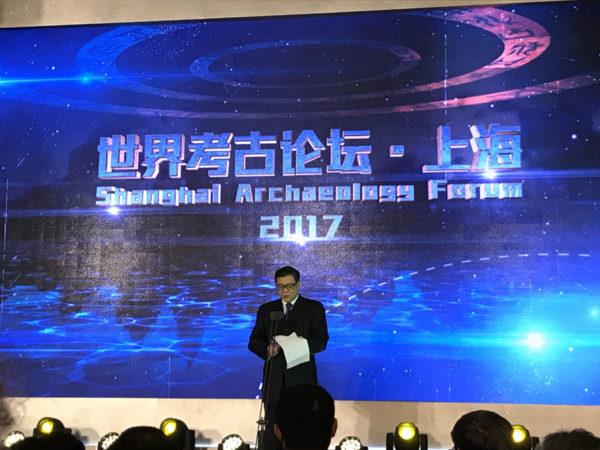
Dr. Wang Wei, Director of the Chinese Academy of Social Sciences, presents his remarks in the opening ceremony. December 8, 2017.
Dozens of international and Chinese students assist (including simultaneous translation of English and Chinese papers so everyone understands), making the incredibly complex, multilingual conference work. The goal shared by those who implement and those who attend is to support sharing information about the best research and the best practices. When I come to the conference, I hear what without a doubt is world-class archaeology from some the most creative research programs around the globe.
At the core of the program is the recognition of 20 awarded projects, ten field discoveries and ten research awards. These were supplemented this year by 11 keynote speakers and 10 talks on recent developments in Chinese archaeology. The final day provided three concurrent sessions offering an additional 18 talks. Nightly lectures by guests invited to the forum speak to the community of Shanghai University students, visiting scholars, and others interested.
This year’s theme was Water, Society, and Civilization, a theme that unified presentations from around the globe. The topic is notable for its relevance for a world where there are many reasons to be concerned about sustainable water management practices and the impact of poor choices. Speakers considered what we can learn from the past in both wet and dry environments. It was also an emphatically local theme, as the conference was held in a region where the Yangtze River empties a watershed that drains one-fifth of the People’s Republic of China—and a place where the ancient cities at Qingbu and Liangzhu, ancient Chinese states, and historic dynasties had massive water projects at their core.
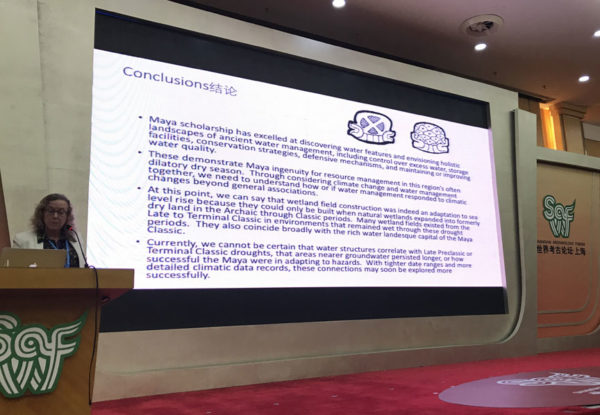
Sheryl Beach discussed water management in the ancient Maya lowlands and considers how her archaeological research might provide some relevance for modern water management in these regions.
Some of the running themes in the projects addressed what have been the crucial questions in archaeology for at least 75 years. For example, when and by what routes did humans move out of Africa, and when did they reach Australia, Madagascar, Easter Island and the Americas? Oldowan culture has recently been found in the southern Caucuses in Russia, and a young human female, named Naia by archaeologists, has been found in a now submerged cave with megafauna off of the Yucatan peninsula.

Seventy-three meters of stratigraphy at the Mukhai II site with an Oldowan component in the southern Caucuses.
More common were papers about the processes behind the transitions from foraging to farming in environments ranging from the mid-continental United States to the rainforests of Borneo.
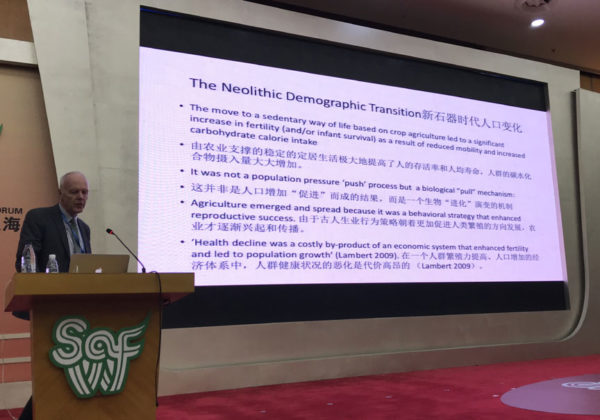
Stephen Shennan discusses the spread of farming during the Neolithic Demographic Transition in Europe. Desert Archaeology and other researchers have evaluated the Neolithic Demographic Transition model in the Southwest United States.
Providing new insights into these fundamental questions are the uniform use of strontium, oxygen and other isotopes to provide provenance of organic samples, aDNA analyses that help identify the genetic relationships between animals—as when exploring questions about whether is the swamp or river buffalo domesticated in south Asia and China–or humans in the detailed analyses of the ethnic barrios of Teotihuacan.
Aggregated radiocarbon data have enabled researchers to synthesize vast databases to look at human migrations in EurAsia and in Europe, and widespread use of Bayesian analyses has increased the precision in evaluations of dynamic processes. Analysis of botanic remains that have identified water lilies in water features in Mesoamerica show that the study of water is not as fundamental as have and have not, but that plant life is a marker that clean safe water is essential and valued. As researchers push the fragmentary material culture of archaeological remains to its interpretive limits and grapple with the ambiguities of open, cave, multicomponent, and urban contexts, the care taken to identify, document, and understand complex stratigraphic sequences was remarkable, and geoarchaeologists work side by side with field teams whether looking for the oldest habitation in the rockshelters of Australia or unearthing carefully placed caches of marine shells and greenstone in the tunnels of Tenochtitlan below Mexico City. What emerges from these studies of archaeological materials, soils, water, animals, and humans themselves is an increasingly precise understanding of the ways that humans use and manage the raw materials of the physical environment.
From these smallest details of physics, biology, and chemistry, we are learning so much more about past human knowledge of the environment and its resources, about the values that shaped choices about what components of the physical environment were extracted, managed, or accommodated, and at what cost. Fundamental transformations include that moment when humans recognized the nutritional value of the milk of other animals as a resource, or dug the first wells in the Levant allowing people to change their ways of settling on the landscape and to farm.
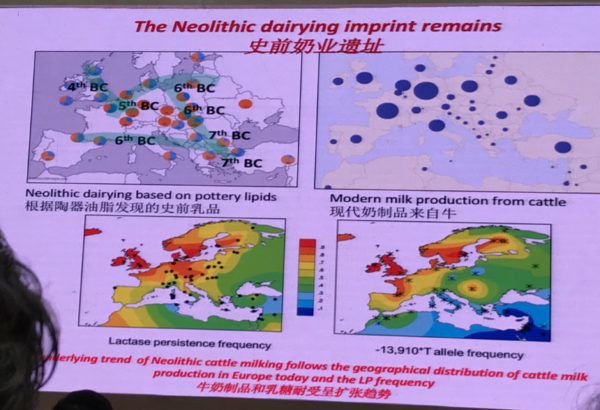
Richard Evershed maps the presence of dairy farming through analysis of lipid (fat) residue in pottery.
Spectacular transformations include the reconstruction of physical landscapes into carefully crafted ideological landscapes that linked the cosmos to the land with astronomically and geometrically placed structures at sites as varied as Cahokia’s lunar landscapes, Israel’s Masada, and Cambodia’s Angkor Wat. Artifacts as small as beads, which are widely traded in the Old World, and the ephemeral remains of cacao residue in the cylinder jars at Chaco Canyon demonstrate links between people across continents when provenance, tools, and technologies are carefully examined.
Photogrammetry is a fully integrated practice and was most remarkably used as Mexican archaeologists described the remote excavations of Naia by divers, not archaeologists. Three-dimensional models created from underwater photography were used to provide instruction to divers about what artifacts to extract, in what order, and to provide fitted packaging for the fragile remains returned to the surface laboratories.
The final theme that seemed to run through the program was the value of collaboration. Virtually every project included an introductory or final slide recognizing partners from multiple institutions, countries, and funding sources. This theme also ran through the dining rooms afterwards as professors from around the world identified shared interests and potential collaborations that would enrich their own research and provide new opportunities and networks for their graduate students.
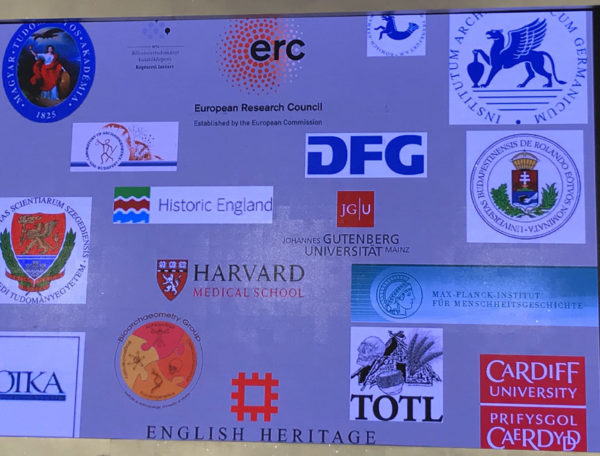
Final slide of the Neolithic at Alsonyek project, showing the scale of collaboration on work at this 80 hectare site that was occupied for over 1,400 years.
Each of these themes has something to offer to CRM. I see the tools being used by the most lauded projects in the world, and they aren’t out of our reach. Some are standard procedure for us; our project directors are refining southern Arizona chronology through Bayesian analyses; and we are careful with our contextual analysis and stratigraphic associations. Other tools we may want to think creatively about. Can we integrate, for example, more isotope analyses into our work in ways that allow our data to contribute to larger regional syntheses?
We already know that our best projects are done in a spirit of collaboration with agencies and clients. We will continue to think creatively how we interface with them, and perhaps think more about our relationships with university colleagues, and most importantly, their students. And I will let the lessons of water lilies in Belize filter through my thinking about canals in our new work at Las Capas and continuing work below the Phoenix airport, as I ponder water and society in less functional ways in the Southwest United States.
Field Discovery Awards:
Graeme Barker (University of Cambridge) for his work on Rainforest Foraging and Farming in Island Southeast Asia
Eszter Banffy (German Archaeological Institute) for work on the Neolithic at Alsonyek in Southern Hungary
Guy D. Stiebel (Tel Aviv University) for his work on King Herod’s usage of water at Masada.
Tomas Sutkina (University of Wollongong in Australia) for their evaluation of the Revised Stratigraphy and Chronology for Homo floresiensis at Liang Bua in Indonesia
James C. Chatters and Pilar Luna Erreguerena (National Institute of Anthropology and History in Mexico) for the Proyecto Arqueologico Hoyo Negro, Quintana Roo, Mexico underwater archaeology project that discovered Naia.
Patricia Crown (University of New Mexico) for Investigating Water Control, Exchange, and Ritual through Excavations of Pueblo Bonito, Chaco Canyon, New Mexico.
Christopher Clarkson (University of Queensland) for identifying 65,000 years of human occupation in Australia
Jaime J. Awe (Northern Arizona University) for The Discovery and Political Significance of the A9 Tomb and Hieroglyphic Panels 3 and 4 at Xunantunich, Belize
Jacques Jaubert (Universite de Bordeaux) for the oldest appropriation of a deep cave environment in the world, Brunquel (France) and the Neanderthals.
Meng Huaping (Hubei Institute of Cultural Heritage and Archaeology) for New Discoveries at Shijahe- a central prehistoric settlement in the Middle Yangzi region.
Research Awards:
Amber VanDerwarker (University of California Santa Barbara) for Water, Drought, and Agriculture, Coping with Conflict and Food Insecurity.
Neal Spencer (British Museum) for Amara West Research Project: Exploring Lived Experience in Pharonic Egypt’s Nubian Colony (1300-800 B.C.)
Karin Margarita-Frei (National Museum of Denmark) for the Tale of the Skrydstrup Woman.
Richard Evershed (University of Bristol) The Milking Revolution in Temperate Neolithic Europe
Barbara W. Fash and William L. Fash (Harvard University) Interdisciplinary Approaches to Investigating and Preserving Copan’s Cultural Heritage
Giorgio Buccellati and Marilyn Kelly Buccellati (University of California, Los Angeles and California State University, Los Angeles) for Archaeology for a Young Future: the New Syrian LIfe of the Ancient City of Urkesh.
Li Liu and Chen Xingcan (Stanford University and Institute of Archaeology, Chinese Academy of Social Sciences) for The Archaeology of China: from the First Villages to the First States.
Hizri Amirkhanov (Institute of Archaeology at the Russian Academy of Social Sciences) for Early Humans at the eastern gate of Europe: The discovery and investigation of Oldowan sites in the northern Caucasus.
He Nu (Institute for Archaeology, Chinese Academy of Social Sciences) for Taosi: the Beginning of “China” and the “Central Plain”
Christopher Scarre (University of Durham) for Editing Antiquity.



